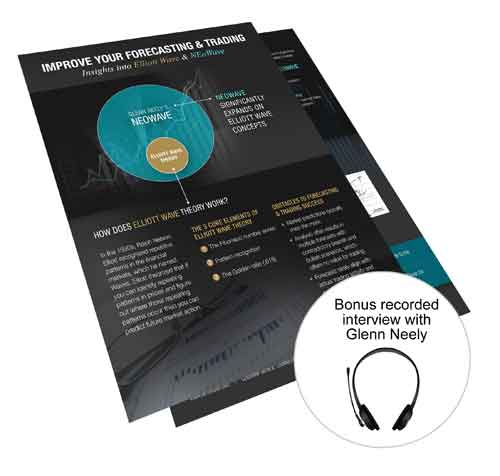NEoWave Blog
9/19/2017 - NEoWave Staff
Top S&P Timer and ElliottWave expert Glenn Neely discusses his trading philosophy: Neely River Trading Technology
Special note: CLICK HERE for Free Tools that will bolster your ElliottWave forecasting and trading.
The September 18, 2017, issue of "Timer Digest" recognizes ElliottWave expert Glenn Neely as a Top 3 Timer for the S&P for the last 3 months. What is Glenn Neely's "secret" to market forecasting and trading? In the following paragraphs, Glenn Neely discusses his trading philosophy, which he calls Neely River Trading Technology.
THE FOLLOWING IS AN EXERPT OF A 3-PART INTERVIEW WiTH GLENN NEELY:
"Introducing Neely River Trading Technology: A Paradigm Shift in Market Trading"
CLICK HERE to listen to the 3-part audio interview with Glenn Neely (or read the transcript) and view the presentation.
I began my career in market forecasting and trading about 1982. For the first year or two I didn’t know anything about ElliottWave theory, and I started investigating all kinds of different market technology and reading all of the books I could read.
I tried to develop some of my own techniques and concepts to help me predict what the markets were going to do. I came up with some interesting and cool things at that time, but nothing really carried me through to my ultimate target or goal. Once I got wind of ElliottWave, I became obsessed with Wave theory.
That was the early stages of my career, and it is typical of just about anyone who gets involved in the stock market. Initially they assume that if you’re going to make money from trading markets, you have to know what the market is going to do. So there is this whole paradigm, what I now call the forecasting paradigm, of markets. I didn’t ever realize that there was any other kind of paradigm for trading and dealing with markets.
I proceeded to study ElliottWave. I assumed that if I understood it and could predict markets really well, I could make money. That was my assumption and that was my goal, so I started working on that for 10 or 15 years.
I noticed during the first few years, like just about everyone, my trading wasn’t very good, and it took a really long time to get better. As my forecasting got better, my trading got better. But I noticed that my forecasting capabilities were increasing almost on a logarithmic scale whereas my trading abilities were increasing on an arithmetic basis, so they were starting to diverge.
Getting better at forecasting and Wave theory didn’t necessarily correlate into better trading or making more money trading. After about 15 years of this, it started to really bother me. I thought, “What’s wrong? Why is this happening? Either my assumption is correct or my assumption isn’t correct.”
The results kept diverging more and more, so I started to think, “Maybe there’s something wrong with my original assumption, perspective, or paradigm about market forecasting being the foundation of good trading.”
That’s when I began to realize the very beginning of separating the market into two paradigms, the trading paradigm and a forecasting paradigm, and realizing that they are two very different things. Just because you’re really good at forecasting doesn’t mean you’re good at trading. And just because you’re good at trading doesn’t mean you’re good at forecasting.
That set me on an entirely new path. This was around the year 2000. Because of my ElliottWave knowledge, I knew the stock market was about to begin a 20- to 30-year bear market, that we were ready to go into a very prolonged sideways consolidation, and that Wave theory is terrible at dealing with trading and predicting huge sideways patterns.
I knew that if I didn’t come up with some new way of dealing with markets, in other words a trading approach and not a forecasting approach, I was going to be pretty much doomed in this business. I would lose all of my family’s money, my money, my clients’ money and everything else.
That’s when I began this entirely new research in how to design an approach to markets that had nothing to do with forecasting and had a completely different way of looking at markets. That was the foundation of the beginning of Neely River Trading Technology. It has developed a great deal. It is pretty sophisticated now, but it is an approach to markets that has nothing to do with forecasting.
The primary crux of successful trading, no matter what approach you use, is RISK MANAGEMENT. Without that, it doesn’t matter what system you use. You’re doomed to failure. You could have a system where you’re 90% right, but if you risk 100% per trade, it only takes one trade and you’ve lost all of your money. That’s not what Neely River Trading Technology is about. Those are axioms of trade. Those are known quantities.
The biggest problem with the forecasting paradigm, which most people don’t even quite understand when they get involved with that process, is that the minute you make a forecast, that is your personal opinion and ego on the line either personally or if you say it to your friends, a group of people, in a newsletter or whatever.
Your reputation or ego is on the line, so you have a vested interest in trying to make sure that forecast becomes correct, so you get emotionally involved in that forecast. That is the death for good trading, because that means you’re going to ignore warning signs and good practices.
It’s the emotional element that forecasting brings to the table that is the real problem with forecasting. If you can remove that, your trading gets much better. I’m going to get into that a little bit later.
Why do I call it Neely River Trading Technology?
“River” has to do with the way markets have a connection to the behavior of water in a river. Why are markets like rivers? Look at Page 2 of the presentation. I’m going to move on to Page 3, and I’m going to discuss it from two perspectives. Let’s first talk about water in a lake environment.
If you’re in a lake environment, that means you have all four walls or quadrants closed off, and you have this random movement that takes place in the water. You might have convection currents. You can have fish moving in the water, wind blowing across the top of the water, and leaves falling in. Everything is almost completely random, and you don’t know what’s going to happen.
Move on to Page 4. Let’s say you were standing near the edge of this lake and had five ping-pong balls in your hand. If you throw those ping-pong balls in the air and – right before they started coming down – if you could freeze time, there’s pretty much no computer or person in the world who could tell you where those five ping-pong balls will end up being in five or 10 minutes, because it’s so random.
That would be a typical chaotic environment in a lake, which you can sometimes connect to market behavior when markets are going sideways in a random, up-and-down fashion as they’ve been doing for most of the last 12 years since 2000. They’ve been going up and down, back and forth in the same range.
You might have random news events that come out. You might be buying and selling on a pretty much equal basis or not much interest in the market, so it produces random, chaotic, unpredictable behavior.
When you get back to the water analogy, the minute things change in a water environment from a lake to some other environment is when gravity begins to take over and one part of this lake breaks down.
Let’s say there’s a dam on one side. If one part of that dam breaks, then you start to get a flow, and gravity will pull the water in one direction. Everything starts to change from that point, so the behavior becomes much more definable and predictable and involves fluid dynamics.
When you’re in a river environment, you have the water moving and gravity is the force pushing it. Near the perimeter of the river, you’ll have turbulence of the oscillating action near the river as the water drags along the edge, creating friction and causing it to spin around both from the top and the bottom, or what I call the north bank and the south bank.
The quickest movement of water will occur toward the center of the river. You have quick movement in the middle and choppier, unpredictable random action near the top and the bottom.
In a river, this creates three zones of behavior. Two are similar. You have a range of turbulence near the north bank and the south bank, and you have more directional movement near the center of the river. Anybody can observe this in any river you want to stand near.
As we move on to markets, the force isn’t gravity. The force in markets is money. Money is what pushes the market up or down. Unlike gravity, which only goes one direction, in a market environment you can go up or down.
Money can be more on the buy side or more on the sell side, which actually doubles the potential complexity of a situation, but you generally have the same overall dynamics taking place.
You have the money pushing the market forward with time, either up or down. If there’s more buying pressure, then prices will be going upward as time goes to the right. If you have more selling pressure, then prices will be going downward as time moves to the right, but the force is money instead of gravity.
The difference here is that you have a different force creating very similar kinds of behavior. I’m sure you’ve seen markets where you’ve had channels above and below market and the market going back and forth inside that channel. If you were to create these channels in a very logical way, which I explain as the theory gets more advanced, it explains how to create these channels completely objectively.
Once you do that, then you can start to see the price movement of the market begin to move in the same manner as it moves inside of a river. These channels will not always be sideways. They sometimes go up. They sometimes go down. They sometimes go way up, way down, or are perfectly horizontal. The behavior inside of that channel will tend to mimic the behavior of water or any kind of object that’s floating on the top of water in a river.
The first step in Neely River Trading Technology is realizing that there is a connection between the behavior of water flowing through a river and the behavior of traders and money flowing through a market.
CLICK HERE to listen to the 3-part audio interview with Glenn Neely (or read the transcript) and view the presentation.
CLICK HERE for Free Tools that will bolster your ElliottWave forecasting and trading.


